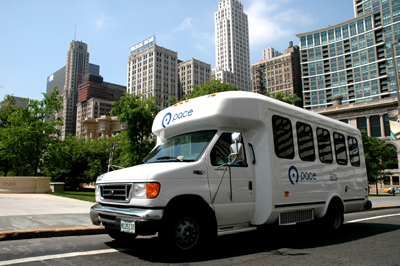
Richard A. Kwasneski

The challenge for any transit system is how to deal with rising costs and shrinking fare revenue and funding, especially for paratransit operations. Federal mandates limit what we can do to cut costs. When an agency has done everything feasible to improve efficiency and is trying to keep fares reasonable for it customers, what’s left?
The fixed costs of transporting customers as opposed to fixed route service mitigate the unpredictable nature of costs to operate paratransit caused by its demand-based structure. Increased ridership on paratransit requires additional drivers and vehicles to keep up with demand, which in turn increases the cost.
Pace Suburban Bus operates fixed route, dial-a-ride, paratransit, vanpool and rideshare services across a six-county region in and around Chicago. Our challenge is to change ridership habits and patterns by making fixed route service more attractive to paratransit customers.
In 2006, when Pace also began operating paratransit within the City of Chicago, taking over for the CTA, the number of registered riders nearly quadrupled 40,000 overnight. The Illinois General Assembly wanted to streamline costs and operations throughout the region using our model of efficiency and customer service.
Through overhauling and modernizing the trip reservation and dispatch processes, we increased capacity, accountability, and efficiency. As a result, demand increased as people enjoyed their improved mobility. Despite increasing trip productivity by nearly doubling the average number of passengers per trip, costs increased because of the influx of passengers.
Sales tax revenues, our source of public funding for transit in our region, fell during 2008 because of the decline of the economy at the same time that costs were increasing because of spikes in ridership. Fixed route service presents the option to reduce service levels to help balance the budget. However, the ADA mandates prevent us from doing the same for paratransit. The last action our Board wants to take is to implement is a sharp fare increase. So, the only other option was to reduce demand on the system by encouraging the use of fixed route service among paratransit customers.
This initiative began with market research to better understand riders’ attitudes toward the use of fixed route service. Focus groups and rider surveys helped us identify the barriers we needed to address. These ran from the convenience of home pick-ups to the uncertainty of knowing whether or not fixed route vehicles would be accessible.
We worked closely with our ADA advisory committees comprised of paratransit riders, independent living workshop facilitators, and other disabled community advocates for feedback on our services.
We started by identifying heavy users of the system; looking at their travel patterns to see if there were straightforward fixed route options available to them, and also to ensure they were aware that the State of Illinois has a program offering free fixed route transit for low-income people with disabilities.
We provided a system map and the fixed route schedules necessary to make their trip, along with a list of potential advantages of using fixed route service. These include the freedom to travel when they’re ready to go — particularly advantageous when leaving medical appointments, which can be highly unpredictable and difficult for us to serve through paratransit. Riders reported often missing trips when their appointments ran longer than expected.

The next hurdle, we learned from our advisory committees, was many riders feared they would lose their paratransit certification if they used fixed route for more of their trips. We had not foreseen this concern and riders met our initial efforts with skepticism when we tried to reassure them. However, we are now seeing this cynicism beginning to subside as time goes on and more paratransit riders are using fixed route and finding their certification is not at risk.
We have been fortunate to have interagency support in the effort, as the Regional Transportation Authority, which provides planning and financial oversight for Pace, Metra and the CTA, has offered its assistance with guiding messaging and finding additional channels to publicize our effort. As we roll out an expanded program to reach a larger number of riders, our partnership with RTA will be critical.
Based on current ridership figures and costs, shifting just 1 percent of our paratransit trips to fixed route will result in a savings of $1 million, with no loss of mobility or independence for passengers. We want to give riders more travel options in a way that will save money for both the passenger and the system. As riders begin considering using fixed route for certain trips on an occasional basis, we will see a gradual reduction in demand.
Results during the pilot project have been very promising. We can gauge the success of the program by our ability to track usage of the People With Disabilities Ride Free card — the “Circuit Permit”— and lift/ramp deployment.
Use of the Circuit Permit grew by more than 20 percent from December 2009 to December 2010, with nearly 1.2 million uses of the cards on Pace fixed route service throughout 2010. This total does not include uses of the pass on CTA bus or rail service in Chicago, where over 70 percent of commuters in the region reside, or Metra commuter rail service. This pass had the second highest growth during the year out of all passes Pace collects.
The increase in lift usage on Pace fixed route service was even more substantial, rising nearly 54 percent from December 2009 to December 2010. Lift usage for all of 2010 was nearly 27 percent higher than the annual total for 2009.
Meanwhile, paratransit ridership fell by roughly 28 percent during 2010 compared to 2009. We realize other external factors may have contributed to this change, but the increase in ramp/lift deployments and Circuit Permit usage certainly speak to a successful effort to convince riders to consider using fixed route service more often. BR
Richard A. Kwasneski serves as Chairman of the Board of Directors for PACE Suburban Bus, South Holland, IL.
